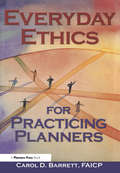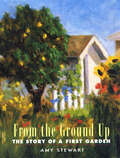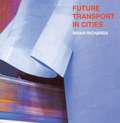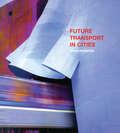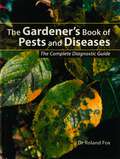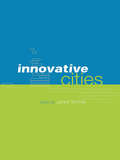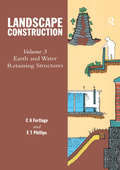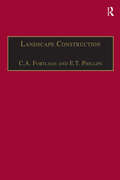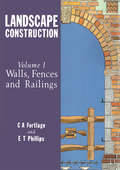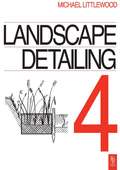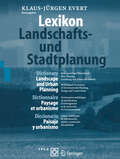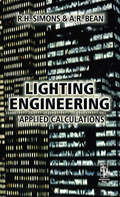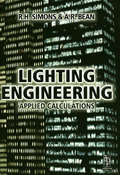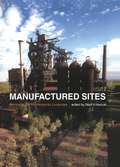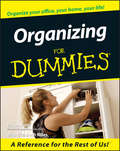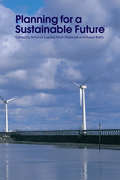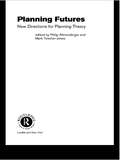- Table View
- List View
Everyday Ethics for Practicing Planners
by Carol Barrett"This book is on the suggested reading list for planners preparing to take the AICP exam. As veteran planner the author points out, the most troublesome conflicts for planners aren't between good and bad, they're between competing good, neither of which can be fully achieved. The 54 real-world scenarios described here typify the tough moral dilemmas that confront today's practioners. The author offers planners a way to recognize the ethical conflicts that arise in everyday practice, analyze them using ""practical moral reasoning,"" apply relevant sections of the AICP Code of Ethics and the APA/AICP Ethical Principles in Planning (both of which are included in full), and decide on the best course of action. The author tells a series of stories-each one a sticky situation that could confront a typical planner. Barrett points out the ethical issues, identifies possible alternatives, and cities relevant sections of the AICP Code. Finally, the author discusses the pros and cons of each alternative. Five particularly complex scenarios are especially intended for group discussion. Individuals studying for the AICP exam will find this book indispensable. But it also should be required reading for every planner who struggles to act ethically and for planning student who wants to understand how professionals define and serve the public interest. Planning agencies, private consulting firms, and planning commissions can use its realistic scenarios to jump start group discussions and workshops on ethical planning."
Everyday Ethics for Practicing Planners
by Carol Barrett"This book is on the suggested reading list for planners preparing to take the AICP exam. As veteran planner the author points out, the most troublesome conflicts for planners aren't between good and bad, they're between competing good, neither of which can be fully achieved. The 54 real-world scenarios described here typify the tough moral dilemmas that confront today's practioners. The author offers planners a way to recognize the ethical conflicts that arise in everyday practice, analyze them using ""practical moral reasoning,"" apply relevant sections of the AICP Code of Ethics and the APA/AICP Ethical Principles in Planning (both of which are included in full), and decide on the best course of action. The author tells a series of stories-each one a sticky situation that could confront a typical planner. Barrett points out the ethical issues, identifies possible alternatives, and cities relevant sections of the AICP Code. Finally, the author discusses the pros and cons of each alternative. Five particularly complex scenarios are especially intended for group discussion. Individuals studying for the AICP exam will find this book indispensable. But it also should be required reading for every planner who struggles to act ethically and for planning student who wants to understand how professionals define and serve the public interest. Planning agencies, private consulting firms, and planning commissions can use its realistic scenarios to jump start group discussions and workshops on ethical planning."
From the Ground Up: The Story of a First Garden
by Amy Stewart"A treasure trove of delightful stories, filled with wit, wisdom, and know-how for all gardens—a rare horticultural treat." —Carl H. Klaus, author of My Vegetable Love and Weathering Winter Amy Stewart had a simple dream. She yearned for a garden filled with colorful jumbles of vegetables and flowers. After she and her husband finished graduate school, they pulled up their Texas roots and headed west to Santa Cruz, California. With little money in their pockets, they rented a modest seaside bungalow with a small backyard. It wasn't much—a twelve-hundred-square-foot patch of land with a couple of fruit trees, and a lot of dirt. A good place to start. From the Ground Up is Stewart's quirky, humorous chronicle of the blossoms and weeds in her first garden and the lessons she's learned the hard way. From planting seeds her great-grandmother sends to battling snails, gophers, and aphids, Stewart takes us on a tour of four seasons in her coastal garden. Confessing her sins and delighting in small triumphs, she dishes the dirt for both the novice and the experienced gardener. Along the way, she brings her quintessential California beach town to life—complete with harbor seals, monarch butterfly migrations, and an old-fashioned seaside amusement park just down the street.Each chapter includes helpful tips alongside the engaging story of a young woman's determination to create a garden in which the plants struggle to live up to the gardener's vision.
Future Transport in Cities
by Brian RichardsCities around the world are being wrecked by the ever-increasing burden of traffic. A significant part of the problem is the enduring popularity of the private car - still an attractive and convenient option to many, who turn a blind eye to the environmental and public health impact. Public transport has always seemed to take second place to the car, and yet alternative ways of moving around cities are possible. Measures to improve public transport, as well as initiatives to encourage walking and cycling, have been introduced in many large cities to decrease car use, or at least persuade people to use their cars in different ways.This book explores many of the measures being tried. It takes the best examples from around the world, and illustrates the work of those architects and urban planners who have produced some of the most significant models of "transport architecture" and city planning. The book examines the ways in which new systems are evolving, and how these are being integrated into the urban environment. It suggests a future where it could be mandatory to provide systems of horizontal movement within large-scale development, using the analogy of the lift, upon which every high-rise building depends. In so doing, future cities could evolve without dependence on the private car.
Future Transport in Cities
by Brian RichardsCities around the world are being wrecked by the ever-increasing burden of traffic. A significant part of the problem is the enduring popularity of the private car - still an attractive and convenient option to many, who turn a blind eye to the environmental and public health impact. Public transport has always seemed to take second place to the car, and yet alternative ways of moving around cities are possible. Measures to improve public transport, as well as initiatives to encourage walking and cycling, have been introduced in many large cities to decrease car use, or at least persuade people to use their cars in different ways.This book explores many of the measures being tried. It takes the best examples from around the world, and illustrates the work of those architects and urban planners who have produced some of the most significant models of "transport architecture" and city planning. The book examines the ways in which new systems are evolving, and how these are being integrated into the urban environment. It suggests a future where it could be mandatory to provide systems of horizontal movement within large-scale development, using the analogy of the lift, upon which every high-rise building depends. In so doing, future cities could evolve without dependence on the private car.
Herbal: The Essential Guide To Herbs For Living
by Deni BownAs the New Year arrives with its seasonal colds, this book proves to be an invaluable companion for effective homeopathic relief.
Innovative Cities
by James SimmieInnovative Cities presents a unique international comparison of innovation in Amsterdam, London, Milan, Paris and Stuttgart. Based on research funded by the ESRC program on 'Cities: Competitiveness and Cohesion', it compares and contrasts the reasons why these sites are among the top ten innovative cities in Europe. Innovation is one of the key driving forces of economic growth in modern economies.The research reported here takes a careful and directly comparable look at what characteristics and conditions in the five cities have led to the flourishing of innovation in them. Researchers with detailed local knowledge have applied the same analytical tools and survey techniques to investigating this question and the result present a unique international comparison of innovation in the five cities.
Innovative Cities
by James SimmieInnovative Cities presents a unique international comparison of innovation in Amsterdam, London, Milan, Paris and Stuttgart. Based on research funded by the ESRC program on 'Cities: Competitiveness and Cohesion', it compares and contrasts the reasons why these sites are among the top ten innovative cities in Europe. Innovation is one of the key driving forces of economic growth in modern economies.The research reported here takes a careful and directly comparable look at what characteristics and conditions in the five cities have led to the flourishing of innovation in them. Researchers with detailed local knowledge have applied the same analytical tools and survey techniques to investigating this question and the result present a unique international comparison of innovation in the five cities.
Landscape Construction: Volume 3: Earth and Water Retaining Structures
by E.T. PhillipsLandscape Construction Volume 1 deals with elements of landscape construction which are required to provide enclosure, privacy, demarcation of land, shelter and security. The elements discussed include free-standing brick and stone walls, fences, gates and railings. Fittings and finishes are also covered. Each section describes the materials, construction and constraints relevant to the subject and a large number of detailed figures and photographs supplement the text and help to illustrate the more important aspects. There is also a section on preservation treatment and painting. The current British Standard references are included.
Landscape Construction: Volume 2: Roads, Paving and Drainage
by C.A. Fortlage E.T. PhillipsLandscape Construction Volume 1 deals with elements of landscape construction which are required to provide enclosure, privacy, demarcation of land, shelter and security. The elements discussed include free-standing brick and stone walls, fences, gates and railings. Fittings and finishes are also covered. Each section describes the materials, construction and constraints relevant to the subject and a large number of detailed figures and photographs supplement the text and help to illustrate the more important aspects. There is also a section on preservation treatment and painting. The current British Standard references are included.
Landscape Construction: Volume 1: Walls, Fences and Railings
by E.T. PhillipsLandscape Construction Volume 1 deals with elements of landscape construction which are required to provide enclosure, privacy, demarcation of land, shelter and security. The elements discussed include free-standing brick and stone walls, fences, gates and railings. Fittings and finishes are also covered. Each section describes the materials, construction and constraints relevant to the subject and a large number of detailed figures and photographs supplement the text and help to illustrate the more important aspects. There is also a section on preservation treatment and painting. The current British Standard references are included.
Landscape Construction: Volume 2: Roads, Paving and Drainage
by C.A. Fortlage E.T. PhillipsLandscape Construction Volume 1 deals with elements of landscape construction which are required to provide enclosure, privacy, demarcation of land, shelter and security. The elements discussed include free-standing brick and stone walls, fences, gates and railings. Fittings and finishes are also covered. Each section describes the materials, construction and constraints relevant to the subject and a large number of detailed figures and photographs supplement the text and help to illustrate the more important aspects. There is also a section on preservation treatment and painting. The current British Standard references are included.
Landscape Detailing Volume 4
by Michael LittlewoodWell established as a valuable source of reference for architects, landscape architects, professionals and students designin external works. This volume covers water features and offers drawings detailed to scale, unlike many of the other books on the market which only deal in sketch forms.Covers landscape ponds, streams and waterfalls, fountains, edges, bank protection, revetments, dams, weirs and sluices, island rafts and jetties and drainage. Each section begins with technical guidance notes on design and construction. This is followed by a set of drawn-to-scale detail sheets. These details can be traced for direct incorporation into the set of contract drawings. A ready reference for landscape designers and an indispensable time-saving tool, Landscape Detailing is an essential for the design office.
Landscape Detailing Volume 4: Enclosures
by Michael LittlewoodWell established as a valuable source of reference for architects, landscape architects, professionals and students designin external works. This volume covers water features and offers drawings detailed to scale, unlike many of the other books on the market which only deal in sketch forms.Covers landscape ponds, streams and waterfalls, fountains, edges, bank protection, revetments, dams, weirs and sluices, island rafts and jetties and drainage. Each section begins with technical guidance notes on design and construction. This is followed by a set of drawn-to-scale detail sheets. These details can be traced for direct incorporation into the set of contract drawings. A ready reference for landscape designers and an indispensable time-saving tool, Landscape Detailing is an essential for the design office.
Lexikon — Landschafts- und Stadtplanung / Dictionary — Landscape and Urban Planning / Dictionnaire — Paysage et urbanisme / Diccionario — Paisaje y urbanismo: Mehrsprachiges Wörterbuch über Planung, Gestaltung und Schutz der Umwelt / Multilingual Dictionary of Environmental Planning, Design and Conservation / Dictionnaire multilingue de planification, d’aménagement et de protection de l’environnement / Léxico multilingüe de planificación, diseño y protección del medio ambiente
by E. B. Ballard IFLA-Arbeitsgruppe "Übersetzung techn. Begriffe" B.de W. Coffin D. Elsworth W. Oehme I. Oquinena J. M. Schmerber R. E. StipeSeit etlichen Jahrzehnten bin ich mit der internationalen Ich bin über diese Entwicklung sehr glücklich, denn so Föderation der Landschaftsarchitekten innig verbunden. Als haben doch die damalige Zusammenarbeit und gemein freiberuflicher Landschaftsarchitekt wurde ich das erste samen Überlegungen über dieses dringend benötigte Wör Mal im Jahr 1962 nach Israel zum dortigen Kongress in terbuch Früchte getragen. Damals ging ich noch von der Haifa eingeladen, später folgten Japan und viele andere Vorstellung aus, dass das eigentlich in 4-5 Jahren erreicht Orte in vielen Ländern, die fiir einen internationalen werden könnte, aber da hier die Gelder fiir wissenschaft Kongress ausgewählt wurden. Seit 1966 vertrat ich als liche Kräfte fehlten, da sie von keiner Institution zur Ver Mitglied des Deutschen Bundes der Landschafts- und fUgung gestellt wurden, musste die freiwillige Arbeit Gartenarchitekten unsere Vereinigung bei den internatio Vorrang haben. Es war deshalb Idealismus verlangt und nalen Besprechungen, auf regionalen Ebenen und im diesen haben die Bearbeiter dieses Lexikons im Team Bereich der Welt. Etliche Jahre Vizepräsident der IFLA, aufgebracht. So ist es mir eine große Freude, diese einlei dann in den Jahren 1978-1982 Präsident, später als Past tenden Sätze zu schreiben und nochmals meinen Dank President immer aktiv fiir die Belange unseres W eltbundes, auszusprechen fiir den Arbeitswillen und die Energie aller konnte ich genügend Übersicht über Struktur, Ausbildung Mitwirkenden. und Arbeitsziele und -bereiche unseres Berufes gründlich kennen lernen.
Lighting Engineering: Applied Calculations
by R. H. Simons A.R. Bean'Lighting Engineering: Applied Calculations' describes the mathematical background to the calculation techniques used in lighting engineering and links them to the applications with which they are used. The fundamentals of flux and illuminance, colour, measurement and optical design are covered in detail. There are detailed discussions of specific applications, including interior lighting, road lighting, tunnel lighting, floodlighting and emergency lighting. The authors have used their years of experience to provide guidance for common mistakes and useful techniques including worked examples and case studies.The last decade has seen the universal application of personal computers to lighting engineering on a day-to-day basis. Many calculations that were previously impracticable are therefore now easily accessible to any engineer or designer who has access to an appropriate computer program. However, a grasp of the underlying calculation principles is still necessary in order to utilise these technologies to the full. Written by two of the leading authorities on this subject, 'Lighting Engineering' is essential reading for practising lighting engineers, designers and architects, and students in the field of lighting.
Lighting Engineering: Applied Calculations
by R. H. Simons A.R. Bean'Lighting Engineering: Applied Calculations' describes the mathematical background to the calculation techniques used in lighting engineering and links them to the applications with which they are used. The fundamentals of flux and illuminance, colour, measurement and optical design are covered in detail. There are detailed discussions of specific applications, including interior lighting, road lighting, tunnel lighting, floodlighting and emergency lighting. The authors have used their years of experience to provide guidance for common mistakes and useful techniques including worked examples and case studies.The last decade has seen the universal application of personal computers to lighting engineering on a day-to-day basis. Many calculations that were previously impracticable are therefore now easily accessible to any engineer or designer who has access to an appropriate computer program. However, a grasp of the underlying calculation principles is still necessary in order to utilise these technologies to the full. Written by two of the leading authorities on this subject, 'Lighting Engineering' is essential reading for practising lighting engineers, designers and architects, and students in the field of lighting.
Manufactured Sites: Rethinking the Post-Industrial Landscape
by Niall Kirkwood**This title was originally published in 2001. The version published in 2011 is a PB reprint of the original HB** Manufactured Sites focuses on the legacy of industrial production and pollutants on the contemporary landscape and their influence on new scientific research, innovative site technologies and progressive site design. It presents innovative environmental, engineering and design approaches along with ongoing research and built projects of international significance. Contributions range from innovative scientific engineering research from industry and federal agencies to contemporary international and regional professional reclamation and redevelopment projects such as the 2000 Olympic Games in Sydney, Australia and the A.G. Thyssen steelworks and blast furnace planning in Germany's Ruhr region.
Manufactured Sites: Rethinking the Post-Industrial Landscape
by Niall Kirkwood**This title was originally published in 2001. The version published in 2011 is a PB reprint of the original HB** Manufactured Sites focuses on the legacy of industrial production and pollutants on the contemporary landscape and their influence on new scientific research, innovative site technologies and progressive site design. It presents innovative environmental, engineering and design approaches along with ongoing research and built projects of international significance. Contributions range from innovative scientific engineering research from industry and federal agencies to contemporary international and regional professional reclamation and redevelopment projects such as the 2000 Olympic Games in Sydney, Australia and the A.G. Thyssen steelworks and blast furnace planning in Germany's Ruhr region.
Organizing For Dummies (For Dummies Ser.)
by Eileen Roth Elizabeth MilesWhat’s the favorite four-letter word of people who are less than fully organized? “Help!” So many technological, social, and economic changes affect your life that you need organization just to keep up, let alone advance. Many people have two jobs – one at the office and one taking care of things at home. If you have a family, you may count that as a third job. Caring for elderly relatives or have community commitments? You can count off four, five, and keep right on going. No matter what life stage you’re in, getting organized can make every day better and help you achieve your long-term goals. Organizing For Dummies is for anyone who wants to Polish his or her professional reputation Experience less stress Increase productivity Build better relationships Maximize personal time Organization isn’t inherited. With the human genome decoded, the evidence is clear: DNA strings dedicated to putting things into place and managing your time like a pro are nonexistent. Instead, organization is a learned skill set. Organizing For Dummies helps you gain that skill with topics such as: Understanding how clutter costs you in time, money, and health Training your mind to be organized and developing a plan Cleaning house, room by room, from basement to attic (including the garage) Creating functional space for efficiency and storage Time-management strategies for home, office, and tavel Scheduling, delegating, and multitasking Making time for your family Managing your health – physical and financial Finding time for love Organizing and cashing in on a great garage sale Getting organized is about unstuffing your life, clearing out the dead weight in places from your closet to your calendar to your computer, and then installing systems that keep the good stuff in its place. Organizing is a liberating and enlightening experience that can enhance your effectiveness and lessen your stress every day – and it’s all yours simply for saying “No” to clutter.
Planning for a Sustainable Future
by Sue Batty Simin Davoudi Antonia LayardSustainable Development is now firmly on the planning agenda and is an issue neither practitioner nor academic can afford to ignore. Planning for a Sustainable Future provides a multi-disciplinary overview of sustainability issues in the land use context, focusing on principles and their application, the legal, political and policy context and the implication of sustainable development thinking for housing, urban design and property development as well as waste and transport. The book concludes by considering how sustainable and unsustainable impacts alike can be measured and modelled, providing real tools to move beyond rhetoric into practice.
Planning for a Sustainable Future
by Antonia Layard Simin Davoudi Susan BattySustainable Development is now firmly on the planning agenda and is an issue neither practitioner nor academic can afford to ignore. Planning for a Sustainable Future provides a multi-disciplinary overview of sustainability issues in the land use context, focusing on principles and their application, the legal, political and policy context and the implication of sustainable development thinking for housing, urban design and property development as well as waste and transport. The book concludes by considering how sustainable and unsustainable impacts alike can be measured and modelled, providing real tools to move beyond rhetoric into practice.
Planning Futures: New Directions for Planning Theory
by Philip Allmendinger Mark Tewdwr-JonePlanning theory is currently in a confused state as a consequence of a number of changes over the last ten years in planning practice and social and economic theory. Even prior to these events, planning theory was an uncertain discipline, reflecting planning's precarious position between and resting upon a range of professional subject areas and philosophical roots. Planning Futures is an attempt to pin down the constantly evolving landscape of planning theory and to chart a path through this fast changing field.Planning Futures is an up-to-date reader on planning theory, but adds something more to the subject area than a mere textbook. The contributors have attempted to bridge theory and practice while putting forward new theoretical ideas. By drawing upon examples from planning practice and case study scenarios, the authors ensure that the work discusses planning theory within the context of present planning practice. Case studies are drawn from an international arena, from the UK, Europe, South Africa and Australia.
Planning Futures: New Directions for Planning Theory
by Philip Allmendinger Mark Tewdwr-JonesPlanning theory is currently in a confused state as a consequence of a number of changes over the last ten years in planning practice and social and economic theory. Even prior to these events, planning theory was an uncertain discipline, reflecting planning's precarious position between and resting upon a range of professional subject areas and philosophical roots. Planning Futures is an attempt to pin down the constantly evolving landscape of planning theory and to chart a path through this fast changing field.Planning Futures is an up-to-date reader on planning theory, but adds something more to the subject area than a mere textbook. The contributors have attempted to bridge theory and practice while putting forward new theoretical ideas. By drawing upon examples from planning practice and case study scenarios, the authors ensure that the work discusses planning theory within the context of present planning practice. Case studies are drawn from an international arena, from the UK, Europe, South Africa and Australia.
